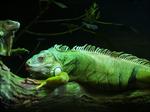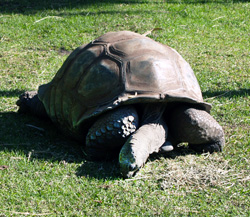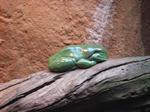
Study Herpetology Online
This course gives you the flexibility to study the course material at your own time and pace. Unlike other online courses, our herpetology course provides you with an enhanced learning experience with the inclusion of tasks to apply your learning to the "real world'.
Herpetology is the study of reptiles and amphibians. The term is derived from Linneas’s classification in which he combined reptiles and amphibians into the one category. Herpetology examines the biology and ecology of these animals and their importance at a global scale. Herpetology as a scientific study and as a hobby can have positive impacts on the conservation of threatened reptile and amphibian species.
Lesson Structure
There are 9 lessons in this course:
- Introduction to Herpetology
- Class Reptilia (Reptiles)
- Reptile Biology
- Class Amphibia (Amphibians)
- Amphibian Biology
- Ecology of Reptiles
- Ecology of Amphibians
- Conservation Issues
- Keeping Reptiles and Amphibians
Each lesson culminates in an assignment which is submitted to the school, marked by the school's tutors and returned to you with any relevant suggestions, comments, and if necessary, extra reading.

Aims
- Discuss the nature and scope of reptiles.
- Identify credible resources, and begin to develop networking with organisations and individuals involved with the study of reptiles around the world.
- Describe a range of different reptile species, including distinguishing characteristics, their needs (eg. environmental, food, etc) and behaviour.
- Identify and explain the anatomy and physiology of reptiles
- Discuss the nature and scope of amphibians
- Identify credible resources, and begin to develop networking with organisations and individuals involved with the study of amphibians around the world.
- Discuss the nature and scope of amphibians
- Identify credible resources, and begin to develop networking with organisations and individuals involved with the study of amphibians around the world.
- Describe the ecological requirements, reproduction and lifecycles of amphibians
- Describe the behaviour of a range of different amphibian species.
- Explain conservation issues that are impacting upon populations of reptiles and amphibians.
- Explain the management of reptiles and amphibians in captivity
 FEEDING REPTILES
FEEDING REPTILES
Healthy reptiles can fast for long periods without effect. If they are in good condition, they can fast for several months. Snakes eat twice weekly, or less; lizards eat daily. Scent is particularly important in food selection for snakes.
Feeding activity is temperature dependent. Sub optimal conditions are often the reason for fasting. If you increase the temperature and give a reptile a warm bath, this can encourage it to feed (even increasing light can have an effect). Disturbances of any type can cause regurgitation. For carnivores, the best diet is a whole animal as this reproduces the diet conditions in nature.
Bearded Dragons
- Omnivorous
- Feed once a day (twice a day for young)
- Feed late morning to help with digestion
- 50/50 ratio of plant to meat for young
- 65/35 ratio of plant to meat for older lizards
- Plant materials – pumpkin, sweet potato, corn, celery leaves, tomato, spinach, zucchini and fruits.
- Animal materials – crickets, meal worms, woodies, pinkie mice, earthworms, canned dog and cat food (no fish) and raw meat (organ meat especially)
- Length of food should be no longer than the lizards head
- Provide calcium supplement with each food for juveniles and every alternate feed for adults
Blue-tongued Lizards
- Omnivorous
- Feed every day (around late-morning to allow them to digest food)
- Feed 1/3 protein (animal) and 2/3 plant material
- Mix food thoroughly and provide in a large container
- Plant materials – fruit (especially bananas), vegetables and grains
- Animal materials – crickets, mealworms, woodies, pinkie mice (frozen then thawed), earthworms, canned dog and cat food (not fish), raw meat (without fat) and garden snails (ensure that no snail baits around).
- Food pieces should be less than 1/3 the size of the head of the lizard
- Supplements – calcium. With each feed in juveniles and with every second feed in adults
Herbivorous Lizards
- Include Green Iguanas (which are folivores – feeding on leaves in the wild)
- Fruit and vegetables
- Rice and grain can also be offered
- Lay out grassy and leafy vegetables
- Provide supplements throughout winter when fruit is not as plentiful or if lizard seems ill
- Add supplements gradually as the scent may turn them off the food
Pythons
- All snakes are carnivores, and most eat small invertebrates.
- Food size will depend on python size
- Hatchlings – pinkie mice
- Once python reaches 60cm long, should be able to eat adult mice
- Do not feed live prey as this can be dangerous for the python
- Only offer food three days after the snake has passed waste (do not feed more than once a week)
Tortoises
- Lettuce, clover, grass, tomatoes, fruit, cucumber
- They will sometimes eat raw fish or meat which should be supplemented with calcium carbonate at a rate of 0.5gm per 100 gms of meat fed.
- Cereals, bread, tinned dog food can also be tried (but in small quantities ...too much can cause liver disease).
Terrapins
- Chopped meat, heart, liver, fish (whole or pieces), snails, shrimps, worms, insects, frogs, mealworms, baby mice.
- Vegetables such as lettuce can be given on alternate days
- Meat must be supplemented with calcium (same ratio as with tortoises).
Reptiles in General
When force feeding is called for, use a small 2mm diameter, oiled polythene tube, attached to a syringe. Gently introduce it into the mouth of the animal and pass it into the food pipe. This way you can feed pulverised whole animal or canned dog food, minced egg, or baby foods.

AMPHIBIANS
There are a wide range of amphibian species kept as pets across the world. Below are just a few of the popular varieties. Of course, the popularity of certain species will vary greatly from country to country.
Salamanders and Newts
- Axolotl Salamander or Mexican Walking Fish Ambystoma mexicanum
- Tiger Salamander Ambystoma tigrinum
- Marbled Salamander Ambystoma opacum
- Mudpuppies Necturus and Proteus spp
- California Newt Taricha torosa
- European Newts Tylototriton sp.
- Crested Newts Triturus sp.
Frogs and Toads
- African Dwarf Frog Hymenochirus sp
- American Green Tree Frog Hyla cinerea
- African Clawed Frog Xenopus laevis
- Australian Green Tree Frog or White’s Tree Frog Litoria caerulea
- American Bull Frog Rana catesbeiana
- Oriental Fire-bellied Toad Bombina orientalis
- American toad Bufo americanus
FEEDING AMPHIBIANS
Axolotls
- Axolotls are carnivorous (meat-eaters)
- Feed daily
- Axolotls require additional feeding at lower temperatures as their metabolism speeds up
- Earthworms, insects, small fish, crustaceans and tadpoles
- Pellet food
- Prepared beef, heart and liver
- Best fed in the evening when they are most active
Newts
- Carnivorous
- Eat worms, insects and crustaceans
- Usually prefer live food, then frozen, then dry
- Live earthworms are a good food (ensure pesticide-free), nightcrawlers, bloodworms, live crickets, slugs, spiders and bugs
Frogs and Toads
- They prefer live food. They love crickets and worms.
- Will also eat cockroaches, flies, white worms, earthworms, fruit flies, fly larvae and meal worms
- Feed 10-20%
- Require mineral and vitamin supplements as most captive insects lack the correct calcium to phosphorus ratio needed for healthy bones.
- Provide calcium supplements to insects 48 hrs prior to feeding them to pet. Can also coat insect in powdered multivitamin preparations.
A good supply of insects can be caught by hanging a light bulb over a funnel that sits over a topless jar. The insects will fill the jar at night, and can then be given to the frogs or toads.
ENROL AND LEARN MORE
In this course you will develop an ability to understand the biological and ecological characteristics of reptiles and amphibians as well as relevant conservation issues and how to keep them at home. Our foundation course in Herpetology will not disappoint.